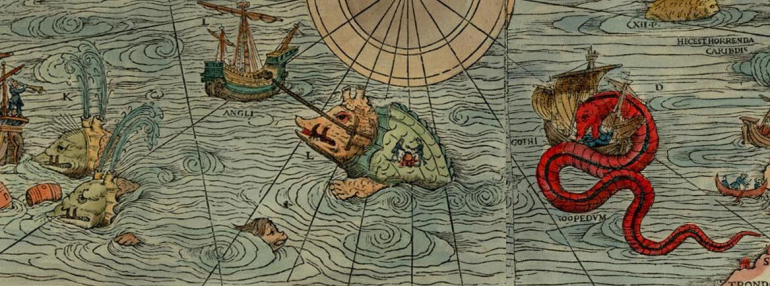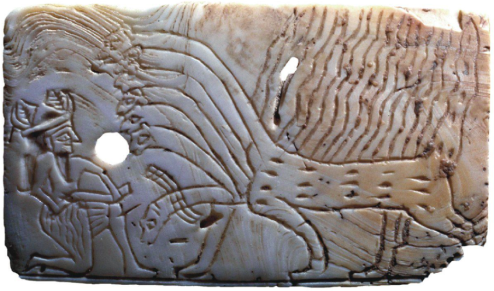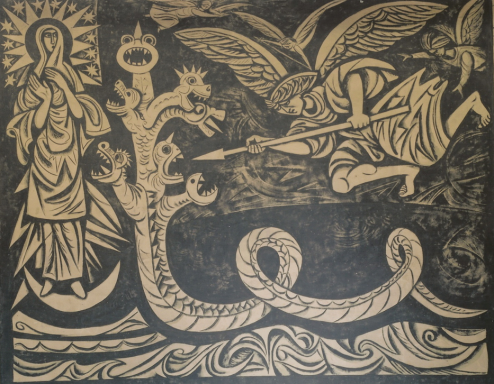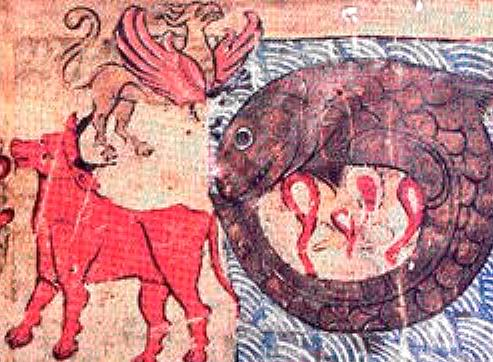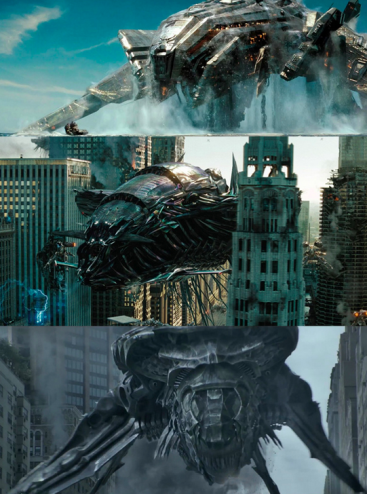The recent find on October 13th of a dead, 18 foot oarfish off the California coast brought to mind all the books I read as a child about sea monsters. Seeing the pictures of the long, narrow body of the typically deep sea fish (which can actually grow up to over 50 feet), it is easy to understand why sailers of an earlier time would have thought, on the rare occasion one approached the surface, that it was a giant “sea serpent“. Coincidentally, the Smithsonian ran a fascinating article just a few days later promoting the release of two new books (here and here) dealing with maps and sea monsters.
Sea Monsters, Dragons, and the Bible
I think there has always been something about oceans, seas, and deep-water lakes that have fascinated humanity with their mystery. It’s like having (literally) an unfathomable alien world living right next to us, and for the ancients this was an alternate universe of sorts, complete with it’s own population of strange (and therefore dangerous) creatures.
In the Ancient Near East, both seas and rivers were recognized for their power and inherent danger, and, in some Near Eastern societies, they were depicted as gods. The Hebrew words for sea (yam) and river (nahar) in Ugaritic texts have the same roots as the names for the tumultuous sea and river god (Yammu and Naharu) who is defeated by by the storm-god Baal-Hadad:
So the mace whirls in Baʿlu’s hand,
[like] a hawk in his fingers,
Strikes Prince [Yammu] on the head,
Ruler Naharu on the forehead.
Yammu goes groggy,
falls to the ground;
His joints go slack,
his body slumps.
Baʿlu grabs Yammu and sets about dismembering (him),
sets about finishing Ruler Naharu off . . .
Mighty Baʿlu disperses him . . .CTA 2, William W. Hallo and K. Lawson Younger Jr., eds. Canonical Compositions from the Biblical World. vol. 1 of The Context of Scripture. Accordance electronic ed. (Leiden: Brill, 2003), 249.
At other times the depths of seas and rivers were seen as containing giant creatures (sometimes referred to as dragons or serpents), which caused the raging of the waters, were dangerous to humanity and all of creation, and were only able to be destroyed by a god. Essentially, these creatures were seen as always threatening chaos and destruction for humanity, and therefore needed to either be bounded or destroyed by a greater power (the perfect scenario for a divine-hero story).
In the Enuma Elish, the Akkadian-Babylonian creation epic, the god Marduk kills the rebellious god-mother Tiamat, creates the vault of heaven and the earth from her remains, and takes his father’s place as the chief of the gods. In the Ugaritic myths, Baal also kills the great dragon Lotan (cf. Leviathan in Hebrew) and spreads the remains in the desert, and after overcoming death also becomes the king of the gods in his father’s place.
Baal’s conflict with Lotan is introduced:
When you smite Lôtan, the fleeing serpent,
finish off the twisting serpent,
the close-coiling one with seven heads . . .CTA 6
William W. Hallo and K. Lawson Younger Jr., eds. Canonical Compositions from the Biblical World. vol. 1 of The Context of Scripture. Accordance electronic ed. (Leiden: Brill, 2003), 265.
Ancient sea monsters are found in several places in the Hebrew Bible as well, where the creatures are variously named as Tanniynim, Leviathan, Rachab, and Yam. In some passages the Hebrew Bible closely parallels content found the Ancient Near Eastern myths. Compare the following with the Baal myth above:
“In that day YHWH
with his hard and great and strong sword
will punish Leviathan the fleeing serpent,
Leviathan the twisting serpent,
and he will slay the dragon that is in the sea . . .”(Isaiah 27.1 ESV)
“You divided the sea by your might;
you broke the heads of the sea monsters
[tanniynim, dragons] on the waters.
You crushed the heads of Leviathan;
you gave him as food for the creatures of the wilderness.”(Psalms 74.13–14 ESV)
In the New Testament
New Testament apocalyptic literature builds upon and adapts the images from the Hebrew scriptures. The slaying of the dragon is also found in the book of Revelation, where the mythic imagery of a seven headed dragon is continued to be used (later in the text identified variously as Satan, the ruler of nations, and even Rome):
“And another sign appeared in heaven: behold, a great red dragon [Greek drakōn, Syriac taniyn], with seven heads and ten horns, and on his heads seven diadems.
(Revelation 12:3 ESV)
And I saw a beast rising out of the sea, with ten horns and seven heads, with ten diadems on its horns and blasphemous names on its heads.”
(Revelation 13.1 ESV)
“And he carried me away in the Spirit into a wilderness, and I saw a woman sitting on a scarlet beast that was full of blasphemous names, and it had seven heads and ten horns . . . But the angel said to me, “Why do you marvel? I will tell you the mystery of the woman, and of the beast with seven heads and ten horns that carries her . . . This calls for a mind with wisdom: the seven heads are seven mountains on which the woman is seated . . .”
(Revelation 17.3, 7, 9 ESV)
In this scenario the dragon/serpent Satan is cast to earth from the heavens rather than living in the depth of the seas. This beast is defeated by Michael (who’s name in Hebrew means “who is like God?”), is bound and cast into the pit for a thousand years, and then after a period of release is ultimately cast into the Lake of Fire.
According to the Rabbis
Rabbinic literature also preserves interesting traditions about the sea monsters that build upon the Hebrew scriptures, most notably concerning the Leviathan. In one account God had actually created two Leviathans (one male and one female); but due to the threat they presented to the world, God had to stop their propagation:
“And God created the great sea monsters” (Gen. 1:21) . . . Rabbi Yohanan said, “This refers to Leviathan [Slotki:] the slant serpent, and Leviathan)the tortuous serpent: ‘In that day the Lord with his sore and great and strong sword will punish Leviathan the slant serpent and Leviathan the tortuous serpent’ (quoting Isa. 27: 1).”
Said Rabbi Judah said Rab, “Whatever the Holy One, blessed be He, created in his world did he create male and female, and so, too, Leviathan the slant serpent and Leviathan the tortuous serpent he created male and female, and if they had mated with one another, they would have destroyed the whole world. What did the Holy One, blessed be He, do? He castrated the male and killed the female and salted it for the righteous in the world to come: ‘And he will slay the dragon that is in the sea’ (quoting Isa. 27: 1).
Babylonian Talmud, Baba Batra IV.22 (Neusner Translation)
Further description of the Leviathan depicts it as a fire-breathing beast, hunted by Gabriel (“the mighty one of God”), and which no one can slay without God’s assistance:
When Rabbi Dimi came, he said Rabbi Yohanan said, “Gabriel is destined to organize a hunt [75A] for Leviathan: ‘Can you draw out Leviathan with a fish hook, or press down his tongue with a cord’ (Job. 40:25). And if the Holy One, blessed be He, does not help him, he will never be able to prevail over him: ‘He only that made him can make his sword approach him’ (Job. 40:19).”
When Rabbi Dimi came, he said Rabbi Yohanan said, “When Leviathan is hungry, he sends out fiery breath from his mouth and boils all the waters of the deep: ‘He makes the deep to boil like a pot’ (Job. 41:23). And if he did not put his head into the Garden of Eden, no creature could endure his stench: ‘He makes the sea like a spiced broth’ (Job. 41:23). And when he is thirsty, he makes the sea into furrows: ‘He makes a path to shine after him’ (Job. 41:24).”
Babylonian Talmud, Baba Batra, IV.26-27 (Nuesner Translation)
Regarding the “salting” of the Leviathan’s carcass, the rabbinic tradition also contains traditions concerning the defeat of the dragon at the end of the age and the rewards for the righteous in the “world to come”:
Rabbah said Rabbi Yohanan said, “The Holy One, blessed be He, is destined to make a banquet for the righteous out of the meat of Leviathan: ‘Companions will make a banquet of it’ (Job. 40:30). The meaning of ‘banquet’ derives from the usage of the same word in the verse, ‘And he prepared for them a great banquet and they ate and drank’ (2Ki. 6:23) . . .
“. . . The rest of the creature will be cut up and sold in the markets of Jerusalem: ‘They will part him among the Canaanites’ (Job. 40:30), and ‘Canaanites’ must be merchants, in line with this usage: ‘As for the Canaanite, the balances of deceit are in his hand, he loves to oppress’ (Hos. 12: 8). If you prefer: ‘Whose merchants are princes, whose traffickers are the honorable of the earth’ (Isa. 23: 8).”
Rabbah said Rabbi Yohanan said, “The Holy One, blessed be He, is destined to make a tabernacle for the righteous out of the hide of Leviathan: ‘Can you fill tabernacles with his skin’ (Job. 40:31). If someone has sufficient merit, a tabernacle is made for him; if he does not have sufficient merit, a mere shade is made for him: ‘And his head with a fish covering’ (Job. 40:31). If someone has sufficient merit, a shade is made for him, if not, then a mere necklace is made for him: ‘And necklaces about your neck’ (Pro. 1: 9). If someone has sufficient merit, a necklace is made for him; if not, then an amulet: ‘And you will bind him for your maidens’ (Job. 40:29).
“And the rest of the beast will the Holy One, blessed be He, spread over the walls of Jerusalem, and the glow will illuminate the world from one end to the other: ‘And nations shall walk at your light, and kings at the brightness of your rising’ (Isa. 60: 3).”
Babyonian Talmud, Baba Batra, IV 28-29 (Neusner Translation)
There [Still] Be Dragons
What’s amazing is how powerful and enduring the image of ancient, chaos-creating monsters and dragons from the depths (whether of sea or the heavens) have been. They have remained with us across history and cultures. The Loch Ness Monster is perhaps the most enduring sea-dragon story in the West. Today the mythical idea is captured frequently in our movies (Godzilla, Cloverfield, Pacific Rim, etc), where the creatures are often depicted as mutations or aliens (which I think is used to maintain the mystery of the unknown in the face of our scientific knowledge of the natural world of earth). A new theme seems to be mechanized combinations of dragon images (Transformers: Dark Side of the Moon, Battleship, Avengers). Others have noted the similarities of these images and themes:
Perhaps one of the connections with aliens is that space itself has become the new “Deep” or “Abyss” that is unfathomable to us. The Avengers is an example of a modern combination of all of these historical and modern motifs: mechanized dragons of chaos coming from the ancient depths of space, destroying a humanity that is defenseless against their power, and only super heroes (gods?) can defeat them and restore order. Interestingly, the divine hero who ultimately defeats these creatures isn’t even Thor, who is a god, but it is the scientist/inventor Tony Stark.
